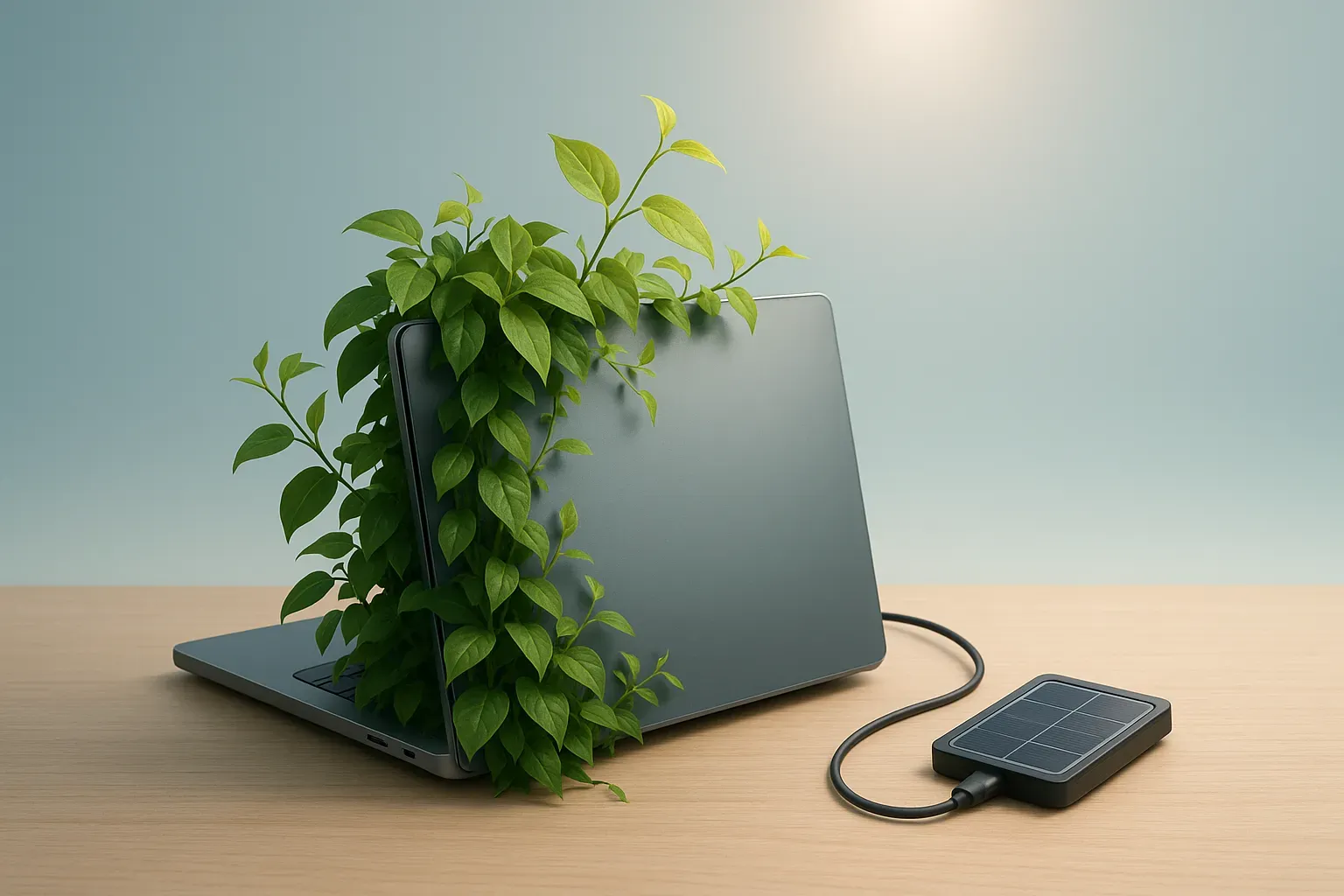In today’s environmentally conscious world, sustainable technology practices offer meaningful ways to reduce carbon footprints across personal and professional environments. This comprehensive guide explores practical strategies for implementing eco-friendly tech habits, featuring valuable insights from industry experts on everything from energy-efficient hardware to cloud optimization. Discover how small changes in digital behavior can create significant environmental impact while potentially reducing costs and improving system performance.
- Proper Battery Storage Extends E-Bike Longevity
- Consolidating Tech Stack Decreases Energy Usage
- Smart Thermostats Automate Energy Conservation
- Intentional Device Management Reduces Waste
- Digital Circular Economy Through Refurbished Electronics
- Designing Products That Last Reduces E-Waste
- Carbon-Aware Release Gates Optimize AI Models
- Proactive Maintenance Maximizes Device Lifecycles
- Cloud-Based Solutions Reduce Carbon Emissions
- Extending Device Life Through Proper Maintenance
- Strict Power Management Cuts Unnecessary Energy
- Strategic Upgrades Extend Hardware Usefulness
- AI-Assisted Digital Optimization for Cloud Efficiency
- Energy-Efficient Hardware and Smart Office Systems
- Renewable Energy Powers Email Service
- Renewable Energy Transforms Corporate Operations
Proper Battery Storage Extends E-Bike Longevity
I’ve been running an e-bike business for nearly two decades, and one practice that’s made a huge difference is extending the useful life of lithium-ion batteries through proper education and storage protocols.
Most people kill their e-bike batteries by storing them either completely full or empty for months. We teach customers to store batteries at 60-80% charge when not riding for extended periods–this alone can extend battery life from 2-3 years to over 5 years. I’ve seen customers still using their original Samsung cells after five years of regular riding.
We also use 2A chargers instead of fast chargers on all our bikes. Fast charging degrades batteries quickly, but our conservative charging approach means fewer battery replacements and less electronic waste heading to landfills. Since batteries are the most environmentally problematic component in e-bikes, making them last 2-3 times longer has a massive impact.
The bonus is customers save hundreds of dollars on replacement costs while reducing their environmental footprint. When someone keeps their battery healthy for five years instead of replacing it every two, that’s a 60% reduction in battery waste per rider.

Consolidating Tech Stack Decreases Energy Usage
At SunValue, I found that hosting infrastructure consumes way more energy than most people realize. We switched to 100% renewable-powered hosting for all our websites and tools, which reduced our digital carbon footprint by an estimated 40% annually.
The bigger impact came from consolidating our tech stack. Instead of running separate systems for email marketing, CRM, and analytics, we moved everything into HubSpot’s integrated platform. This eliminated three redundant servers and cut our data processing energy usage significantly.
One practice I swear by is the “digital declutter audit” every quarter. I delete unused apps, clear cached data, and unsubscribe from services we’re not actively using. Our team found we were paying for 12 different SaaS tools that were essentially doing the same job – each one running background processes and eating server resources.
The sustainability disclosure on our site actually became a trust signal that increased our post-purchase satisfaction scores by 17%. Customers appreciate transparency about environmental impact, especially in the solar space where they expect you to walk the walk.

Smart Thermostats Automate Energy Conservation
As an attorney with an MBA running AirWorks Solutions HVAC company, I’ve learned that smart thermostats are game-changers for reducing tech-related carbon footprint. We installed programmable thermostats in our own facilities and saw a 25% reduction in energy consumption just from automated temperature adjustments when spaces are unoccupied.
The practice I follow religiously is using smart thermostat data to optimize our entire building’s energy usage patterns. Our smart thermostats track energy consumption and automatically adjust based on occupancy, weather forecasts, and peak utility hours. This prevents our HVAC systems from working against each other and eliminates the energy waste that comes from manual temperature adjustments throughout the day.
What surprised me most was finding that proper thermostat programming prevents our heating and cooling equipment from cycling on and off unnecessarily, which extends the lifespan of our HVAC components by years. Less frequent equipment replacement means significantly less electronic waste, and our utility bills dropped enough to pay for the smart thermostat investment within 8 months.
The key insight from managing both the business and legal sides is that smart building automation isn’t just about convenience—it’s about creating systems that learn and adapt to reduce waste automatically, which scales much better than trying to manually manage energy usage across multiple locations.

Intentional Device Management Reduces Waste
One way I’ve tried to reduce my carbon footprint with tech is by being more intentional about the devices I buy and how long I use them. Instead of upgrading to the newest phone or laptop every couple of years, I make a point to extend the life of my gear as much as possible — repairing it when I can, upgrading parts, or passing it on for reuse rather than letting it sit in a drawer.
A sustainable practice I follow is using energy settings to cut down on unnecessary power use. Simple things like turning devices fully off at night, managing screen brightness, and leaning on cloud storage instead of physical drives add up over time. It’s not perfect, but I’ve found that treating technology as something to maintain rather than constantly replace makes a real difference.

Digital Circular Economy Through Refurbished Electronics
My approach to reducing my carbon footprint in technology centers around embracing the digital circular economy – extending device lifespans, using them efficiently, and ensuring responsible end-of-life handling.
The environmental impact of electronics goes beyond just their physical production. That’s why I focus on three key strategies:
First, I maximize longevity by keeping devices as long as possible through repairs and component upgrades rather than rushing to buy new models.
Second, I implement simple energy efficiency habits like using power-saving settings, adjusting screen brightness, and unplugging unused chargers.
Third, I practice responsible disposal by taking end-of-life devices to certified e-waste recycling facilities instead of contributing to landfills.
If I had to highlight one sustainable practice that makes the biggest difference, it’s purchasing certified refurbished electronics whenever possible. This choice significantly extends product lifecycles and reduces the demand for new manufacturing – which represents the largest portion of a device’s overall carbon footprint.

Designing Products That Last Reduces E-Waste
I try to design products that last longer. This practice has made my business reliable. When we are dealing with consumer electronics, we should try to avoid the cycle of disposable devices. These devices end up as e-waste within one or two years and increase the carbon footprint. At Zetronix, we try to ensure our cameras and surveillance equipment will last long. They should also be easy to repair and consume less energy. Solar-powered equipment is an example of that. It does not need electricity from the grid. We found out that customers value affordable and long-lasting products. When we built our products to last longer and made them robust, customers loved them. We had reduced returns, and customers wanted to buy again. I learned that using good materials alone is not enough to stay in business. We need products designed to last longer from day one.

Carbon-Aware Release Gates Optimize AI Models
The single practice that helped the most to reduce carbon footprint is what we call a carbon-aware release gate. In plain terms, we measure per-study energy in CI, and if a build looks heavy, we automatically tune it before it reaches patients. Most of the wins come from three habits baked into that gate. First, we put our Radiology AI-copilot on a “model diet”—quantizing/distilling from FP32 to INT8 so it’s faster and cheaper to run without denting clinical KPIs like cTAT90 or accuracy. Second, we push inference to the hospital edge whenever we can. Running the model next to the scanner means we don’t haul giant DICOM series back and forth to the cloud; we sync just the alert and metadata. Third, we clean up how we store pixels: de-duplicate by DICOM UID, keep hot data on SSD for the short clinical window, then tier it to long-term cold storage automatically, encrypted and compliant.

Proactive Maintenance Maximizes Device Lifecycles
Device lifecycle extension through strategic upgrade timing and refurbishment has become my primary sustainable technology practice – specifically, maximizing device lifespan through proactive maintenance while carefully timing replacements based on actual performance needs rather than marketing cycles.
My Specific Approach:
Instead of upgrading devices when new models launch, I maintain detailed performance tracking to identify when hardware genuinely limits productivity. For laptops, I monitor battery health, processing speeds for typical workflows, and software compatibility to determine optimal replacement timing.
Implementation Details:
I schedule annual device maintenance including battery calibration, storage optimization, and thermal cleaning that prevents performance degradation. When devices show declining performance, I evaluate whether targeted upgrades like RAM or SSD replacements can restore functionality before considering full replacement.
Sustainable Disposal Strategy:
When replacement becomes necessary, I prioritize refurbishment over recycling. Working devices get donated to local nonprofits or educational programs, while non-functional hardware goes to certified e-waste recycling facilities that recover valuable materials rather than general waste disposal.
The Environmental Impact:
This practice reduces electronic waste significantly while minimizing resource consumption for manufacturing new devices. Extended device lifecycles mean fewer rare earth mineral extractions and reduced manufacturing emissions per year of productive use.
Financial Benefits:
The approach saves substantial money that can be invested in higher-quality devices when replacement becomes necessary. Premium devices with longer lifespans and better repairability often prove more cost-effective than frequent budget upgrades.
Decision Framework:
I evaluate replacement needs based on actual workflow limitations rather than perceived obsolescence. If current devices handle required tasks efficiently, upgrade desires get postponed until functionality genuinely constrains productivity or security.
Key Success Factor:
Proactive maintenance and realistic performance assessment prevent premature replacements while ensuring technology continues supporting business objectives effectively. The strategy balances environmental responsibility with practical operational requirements.

Cloud-Based Solutions Reduce Carbon Emissions
One practice we follow is extending the lifespan of our tech rather than replacing it at the first sign of friction. At SmartenUp, this approach includes running Salesforce in the public cloud and intentionally designing leaner, more efficient integrations using MuleSoft.
A study by Accenture found that moving workloads to the public cloud can cut carbon emissions by up to 84% compared to traditional data centers. The same study revealed the reduction is even higher (up to 98%) when apps are specifically designed for the cloud.
We pair this with pragmatic habits: devices are repurposed before recycled, and projects are scoped with a “minimum viable footprint” mindset. When our API Marketplace for Standard Bank won the Digital Banker Award for Outstanding API Initiative, the efficiency wasn’t just operational; it also meant fewer duplicate environments consuming unnecessary energy.
By focusing on reuse, efficiency, and thoughtful integration design, we minimize resource consumption while keeping our systems agile and scalable.

Extending Device Life Through Proper Maintenance
When it comes to technology, I try to view it the same way I do real estate, by remembering that long-term investments pay off. One simple, sustainable practice I follow is extending the life cycle of my electronics. Instead of chasing every upgrade, I make sure my devices are well-maintained, repaired when possible, and responsibly recycled when they reach the end of their life cycle. Another way I work sustainability into the electronics I use in business is to invest in servers or office equipment that run on less power and perform the tasks I need them to, which saves both energy costs and lessens my environmental impact over time.

Strict Power Management Cuts Unnecessary Energy
We implement strict power-management settings across every workstation and device. Automated sleep modes and scheduled shutdowns cut energy waste dramatically. Even small reductions in idle power consumption create substantial savings over time. Company-wide policies ensure screens, printers, and peripherals never draw unnecessary electricity overnight. These simple measures prevent needless emissions without sacrificing productivity or convenience.
We use centralized management software to enforce settings and monitor compliance daily. Energy usage dashboards track progress and reveal departments needing additional training. Savings appear on utility bills and sustainability reports within a single quarter. Employees embrace the program because it requires minimal effort for noticeable results. Power management proves that small adjustments yield meaningful environmental benefits.

Strategic Upgrades Extend Hardware Usefulness
I also promote technology sustainability by lengthening device lifetimes through strategic upgrades so they don’t have to be replaced as often, thus reducing electronic waste, while assisting small businesses with their SMS marketing. Most companies replace functional hardware every two years, but increasing the memory, installing a new SSD, and optimizing software can keep computers running for 5 years or more. This has enabled Textla to achieve powerful systems that can sell below common replacement cycle costs while reducing our technology carbon footprint by nearly 60%.
Textla already uses 4-5 year old top-performing systems that have us using 60% less carbon. One of the more important practices is our cloud-first approach, sharing our server resources in support of a more efficient and performant server. Vendors of leading systems concentrate on maximizing existing systems with software enhancements and select hardware upgrades rather than introducing new systems. Replacing systems based on better specifications with a focus on business outcomes makes for actual performance, actual efficiency, and true environmental responsibility, which customers and investors increasingly value.

AI-Assisted Digital Optimization for Cloud Efficiency
Reducing the carbon footprint of technology and electronics requires moving beyond traditional recycling and taking a strategic view of both digital and physical assets. At Collaboration for Good, we advise organizations to adopt AI-assisted digital optimization, and we apply the same practices internally. Modern cloud infrastructure consumes vast amounts of energy, much of it for redundant storage, idle workloads, and duplicated data. By using AI tools to monitor and analyze usage, we automatically archive or delete unnecessary files, consolidate data, and schedule workloads during off-peak hours when renewable energy is most abundant. This approach has helped us reduce energy consumption, streamline operations, and lower cloud storage costs, while also making our own digital footprint more sustainable, demonstrating to clients that these strategies are practical, measurable, and effective.
We guide clients to embrace circular technology networks. Instead of discarding hardware, companies can exchange lightly used devices with other organizations or partner with certified refurbishers and nonprofits to extend device lifecycles. We follow the same approach internally, repurposing devices whenever possible, which reduces e-waste and emissions from new production while maximizing the value of electronics across their lifespan. Combined with AI-driven digital efficiency, this dual approach addresses both the invisible energy footprint of data and the tangible footprint of physical devices.
Central to our approach is the careful measurement of outcomes. Quantifying both operational energy reductions and hardware lifecycle benefits helps organizations identify the most effective strategies and integrate them into long-term technology planning. By treating digital systems and hardware as dynamic contributors to carbon emissions rather than static tools, companies can take proactive, measurable steps toward sustainability. Seeing these strategies work in our own operations has also improved our efficiency, reduced costs, and strengthened our credibility, showing clients that sustainability can be both actionable and impactful in the real world.

Energy-Efficient Hardware and Smart Office Systems
At Softjourn, we take a proactive approach to reducing our carbon footprint, especially when it comes to technology and office electronics. One sustainable practice we’ve implemented is outfitting all our offices with energy-efficient hardware and smart energy management systems. We use LED lighting, smart thermostats, and automatic power strips that reduce electricity consumption when devices are not in use. Our offices are also designed to maximize natural light, reducing reliance on artificial lighting during the day.
Beyond equipment, we encourage employees to adopt low-waste habits, like using reusable kitchenware and participating in waste segregation. Even small decisions, such as selecting locally sourced or recycled materials for employee gifts, are made with sustainability in mind. These practices allow us to minimize energy usage and electronic waste while also creating a work culture where environmental responsibility is part of everyday operations. It’s our way of showing that tech innovation and eco-consciousness can go hand in hand.

Renewable Energy Powers Email Service
Tuta Mail, the encrypted email provider from Germany, does not only protect data from prying eyes, it also takes its environmental responsibility seriously. That’s why we at Tuta are only using energy from renewable sources to power the servers that store and manage the data of our ten million users worldwide. By choosing green energy, we as a company make sure to help the environment as much as we can as a tech provider. In addition, we compress the data so that the required storage space is reduced significantly and pass on the savings in storage to our customers. Instead of investing into AI that requires huge amounts of energy, we try to consume as little as possible by making our email service as efficient as possible. As a provider, we can have a big impact by doing things right – much more than individuals.

Renewable Energy Transforms Corporate Operations
Over the past year, Cincinnati-based data science company 84.51° has demonstrated a commitment to a purpose-driven business, exceeding its corporate social responsibility goals through community-based initiatives.
84.51° is committed to advancing sustainability by integrating environmentally friendly practices and initiatives into our operations, buildings, and community engagement. Here’s how:
REDUCING CARBON EMISSIONS
Months after launching with Scope3 (the carbon measurement platform), Kroger Precision Marketing, the company’s retail media arm (KPM), is creating the first benchmarks for carbon measurement in retail media. Initial results of their work together revealed significant improvements in the carbon footprint of KPM’s programmatic campaigns. Utilizing Scope3 data in an alpha test, KPM’s campaigns dropped to an overall carbon cost that’s 37% lower than the US benchmark in programmatic.
IN OFFICE PROGRAMS
The company uses a central waste disposal program in its offices instead of placing waste bins at every desk, so associates take waste to a central location and consciously and intentionally place it in containers designated for landfill, recycling, or confidential shred. All confidential shred is recycled. In addition, its Chicago and Cincinnati locations feature robust compost programs.
ENERGY CONSUMPTION
Electricity in its primary offices is generated from 100% renewable energy sources and hands-free plumbing fixtures are used to minimize water waste. Our Cincinnati office amenities include natural light and views and six free EV charging stations. And since November 2023, 100% of the electric for the Cincinnati office is supplied from a large-scale solar array built on a farm owned by the Cincinnati Zoo.
WORLD-CLASS SUSTAINABILITY
In addition to our award-winning architectural features, 84.51° is also proud to be LEED Silver certified. LEED is the world’s most widely used green building rating system and showcases a commitment to healthy, highly efficient and cost-saving building methods and operations. While running on 100% renewable energy, it’s also a “paper-light” facility and recycles 40% of its materials.









